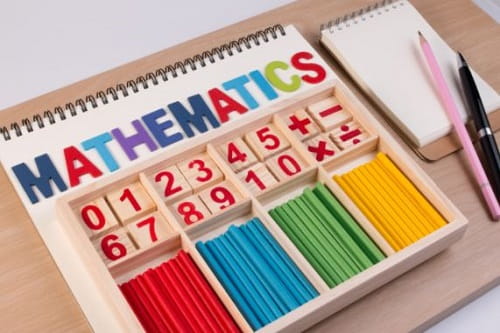Setting up Math Centers in Your Special Education Classroom

Filling 90 minutes of instruction time can be a daunting task, especially if you are new to teaching or block scheduling. Now, factor in that you teach students with limited cognitive abilities in a self-contained setting and needing materials and resources for various multi-level learners, 90 minutes seems a lot longer. Planning this 90 minute block every other day? Yikes!
One way that many teachers have proven effective is to set up math centers in your special education classroom. No matter what level your students are on, there is a way to implement centers that are appropriate for all students. With efficient planning and utilizing your classroom staff, centers can be a successful way to fill each period with meaningful and appropriate instruction.
One thing to remember is that once this system has been established, students will pick up on the routine and how each period is run. Students understand the expectations and grow more independent in some centers, which boosts the effectiveness and success of using centers in the classroom.
Why use centers in a 90 minute Math block?
Meaningful centers help segment your 90 minute block into smaller, more manageable chunks of time and also allow students to have exposure to a variety of activities each day. Look at your class and their needs and see how maybe this plan can work for you!
Every class is different but there is a way to adapt and modify so that this type of system can work for you.
What does this look like in the classroom?
Here’s how we implemented centers in a self-contained classroom with 1 teacher, 2 (sometimes 1) paraprofessionals, and 11 students with Autism & Intellectual Disabilities.
—-
Center 1: Small group with teacher, evidenced based curriculum programs (sometimes did 2 different levels at once).
Most school districts require us to use an evidence based program in our instruction. Once you’ve used placement tests (within whichever program you choose to use), you can group your students as appropriate. Sometimes you get lucky and a few students are in the same group/same level. You will have to be sure to allot enough time to fit each group in each period. The more familiar you are with the program you are using, the better flow this center will have.
Center 2: Math file folders/games/ hands on activities (supervised and run by 1 para)
It’s a great idea to have file folders, Math task boxes, etc. ready to go. Most students have many different skills you can work on at this center. These can be geared towards IEP goals/objectives or other skills where students need additional practice/reinforcement. Keep in mind to not have these activities be so difficult that students need full support, you want them to be challenged but on a level where they can work on their own or with minimal support.
Center 3: Independent worksheets (based on student IEP goals/objectives). This was a supervised station with 1 para, but if I HAD to, these students could do these sheets and ask the other para to check them.
I use these worksheets as another way to collect data. Keep student work to use as samples to support the data you gather on IEP goals/objectives. A helpful tip is on each worksheet, if there’s notes you want to jot down (student self-corrected, had a hard time with _____, 100% accuracy with no assistance, needed minimal support etc.) do so at the bottom- this helps down the line if you need extra info on work samples.
Center 4: Computer games/Apps – there are lots of math games you can find for various skills (I had 2 desktop computers in my classroom).
Another fun way to reinforce skills! There are so many sites/apps for students to play Math games. Most are accessible on the computer and tablets/iPads. There are even sites that have games by grade level.
Again, setting up centers like these takes up front work BUT once it’s all set up, it runs pretty smoothly!! It’s worth it!!
